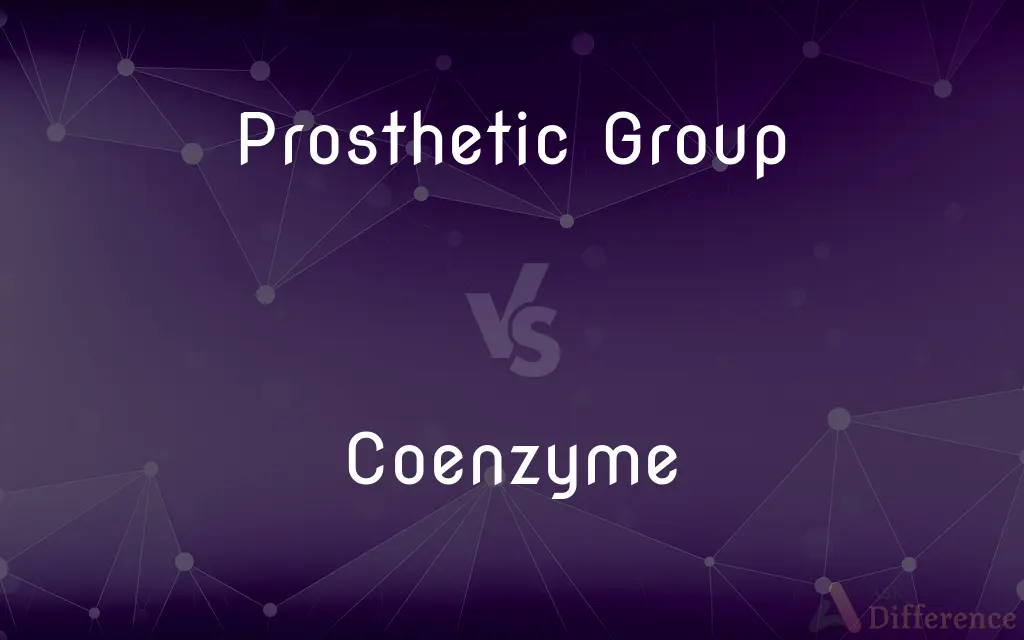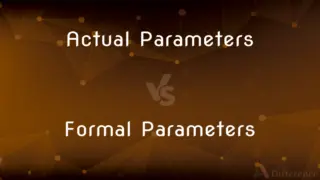Prosthetic Group vs. Coenzyme — What's the Difference?
Edited by Tayyaba Rehman — By Fiza Rafique — Published on January 1, 2024
Prosthetic groups are non-polypeptide units permanently attached to proteins, aiding function. Coenzymes are organic molecules assisting enzymes temporarily during substrate conversion.

Difference Between Prosthetic Group and Coenzyme
Table of Contents
ADVERTISEMENT
Key Differences
Prosthetic groups are non-protein components that bind tightly and permanently to proteins, especially enzymes. Coenzymes, on the other hand, are organic cofactors that associate with enzymes, but they do so on a temporary basis during the course of a reaction.
While prosthetic groups are covalently bound to the enzyme and are not released under normal conditions, coenzymes are typically bound non-covalently and can dissociate from the enzyme post-reaction. This means that while prosthetic groups remain a constant part of the enzyme's structure, coenzymes may move to other enzymes after one reaction is complete.
Functionally, prosthetic groups often help enzymes assume the correct shape or form for their activity. Coenzymes, conversely, often play a role in the transfer of specific atoms or groups during enzymatic reactions, acting as transient carriers.
Examples of prosthetic groups include heme in hemoglobin and the flavin in flavoproteins. Coenzymes include familiar molecules like NAD+ and FAD, which are essential in various metabolic reactions.
Another key distinction lies in their origins. Prosthetic groups are typically synthesized in the cell and integrated into proteins during translation or post-translation. Coenzymes, on the other hand, often originate from dietary vitamins and are not synthesized in large quantities by the cell.
ADVERTISEMENT
Comparison Chart
Binding to Enzyme
Permanently and tightly bound
Temporarily and loosely bound
Function
Aid enzyme structure/function
Transfer specific atoms/groups during reactions
Examples
Heme in hemoglobin, flavin in flavoproteins
NAD+, FAD
Origins
Synthesized in cell
Often from dietary vitamins
Release from Enzyme
Not released under normal conditions
Released after reaction completion
Compare with Definitions
Prosthetic Group
A permanently attached non-protein unit assisting protein function.
The heme in hemoglobin is a prosthetic group that allows the molecule to bind oxygen.
Coenzyme
A transient molecular partner aiding enzyme function during a specific reaction.
FAD acts as a coenzyme in various oxidative reactions.
Prosthetic Group
A molecule that is an integral part of a protein, ensuring its functional activity.
Enzymes involved in respiration often contain prosthetic groups to aid in their operations.
Coenzyme
A non-protein compound necessary for an enzyme's protein activity.
Vitamin-derived molecules often function as coenzymes in metabolic pathways.
Prosthetic Group
A covalently bound molecule that supports the biological activity of a protein.
Cytochromes have prosthetic groups to assist in electron transfer processes.
Coenzyme
An organic cofactor that temporarily associates with enzymes to facilitate reactions.
ATP serves as a coenzyme, providing energy for numerous cellular processes.
Prosthetic Group
An organic or inorganic compound that binds tightly to proteins, especially enzymes.
Myoglobin's function in muscle oxygen storage is supported by its prosthetic group.
Coenzyme
An organic molecule assisting enzymes in substrate conversion.
NAD+ is a coenzyme involved in many redox reactions in the cell.
Prosthetic Group
A non-polypeptide unit that remains bound to a protein throughout the protein's lifecycle.
The flavin in flavoproteins acts as a prosthetic group, playing a crucial role in enzyme activity.
Coenzyme
A molecule working alongside enzymes to ensure effective substrate conversion.
Coenzyme Q10 is important for energy production within cells.
Coenzyme
An organic substance that reversibly combines with a specific protein, the apoenzyme, and with a substrate to form an active enzyme system.
Coenzyme
(biochemistry) Any small molecule that is necessary for the functioning of an enzyme.
Coenzyme
A molecule that is essential for the activity of some enzymes; it may exist free in solution within a living organism, but functions by binding to an enzyme to assist in catalyzing a reaction. The molecule itself may be temporarily changed during the reaction, but is ultimately restored to its original form. Many vitamins function as coenzymes.
Coenzyme
A small molecule (not a protein but sometimes a vitamin) essential for the activity of some enzymes
Common Curiosities
Are all coenzymes derived from vitamins?
Many coenzymes originate from vitamins, but not all.
Do prosthetic groups detach from proteins?
No, prosthetic groups are permanently attached to proteins.
Is the heme in hemoglobin a prosthetic group or coenzyme?
The heme in hemoglobin is a prosthetic group.
Can coenzymes function independently outside enzymes?
Coenzymes typically require association with enzymes to function in reactions.
What's the difference in binding between a prosthetic group and a coenzyme?
Prosthetic groups bind permanently to proteins, while coenzymes bind temporarily.
Why are coenzymes crucial for enzyme function?
Coenzymes often transfer specific atoms or groups during enzymatic reactions.
Are prosthetic groups organic compounds?
Prosthetic groups can be either organic or inorganic.
Can one enzyme have both a coenzyme and prosthetic group?
Yes, some enzymes may contain both, each aiding in specific aspects of the enzyme's function.
How does a prosthetic group aid enzyme activity?
Prosthetic groups can help enzymes assume the correct shape or enhance their reactivity.
Are prosthetic groups found only in enzymes?
While common in enzymes, prosthetic groups can also be found in other proteins.
Is flavin a prosthetic group or coenzyme?
Flavin can act as both, but in flavoproteins, it's typically a prosthetic group.
Do coenzymes get consumed in reactions?
Coenzymes aren't consumed but can change form during reactions.
What happens if a protein lacks its prosthetic group?
Without its prosthetic group, a protein might become non-functional.
Is ATP a coenzyme?
Yes, ATP acts as a coenzyme in many metabolic reactions.
Can coenzymes be recycled in the cell?
Yes, coenzymes can be regenerated and used in multiple reactions.
Share Your Discovery

Previous Comparison
Family vs. Relatives
Next Comparison
Actual Parameters vs. Formal ParametersAuthor Spotlight
Written by
Fiza RafiqueFiza Rafique is a skilled content writer at AskDifference.com, where she meticulously refines and enhances written pieces. Drawing from her vast editorial expertise, Fiza ensures clarity, accuracy, and precision in every article. Passionate about language, she continually seeks to elevate the quality of content for readers worldwide.
Edited by
Tayyaba RehmanTayyaba Rehman is a distinguished writer, currently serving as a primary contributor to askdifference.com. As a researcher in semantics and etymology, Tayyaba's passion for the complexity of languages and their distinctions has found a perfect home on the platform. Tayyaba delves into the intricacies of language, distinguishing between commonly confused words and phrases, thereby providing clarity for readers worldwide.














































